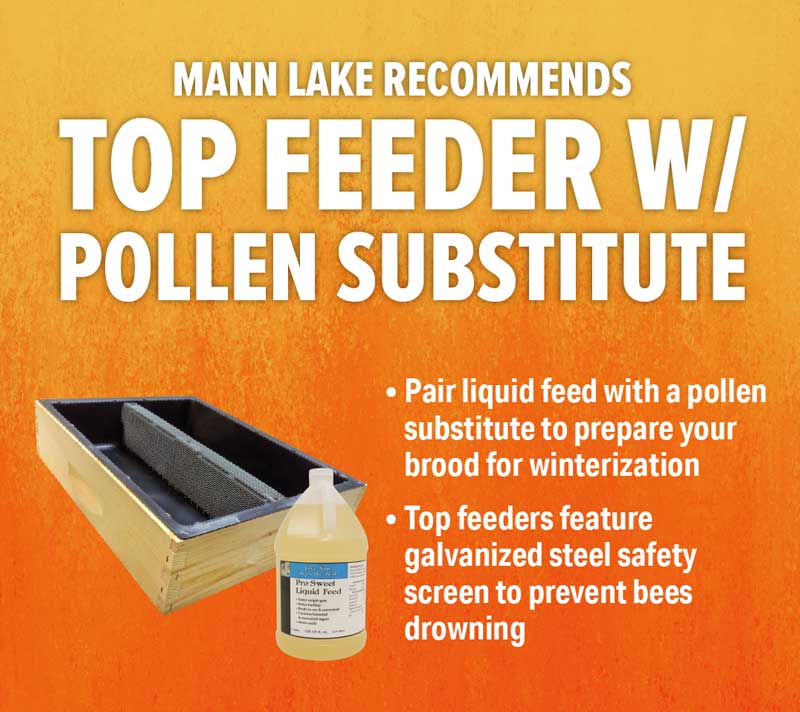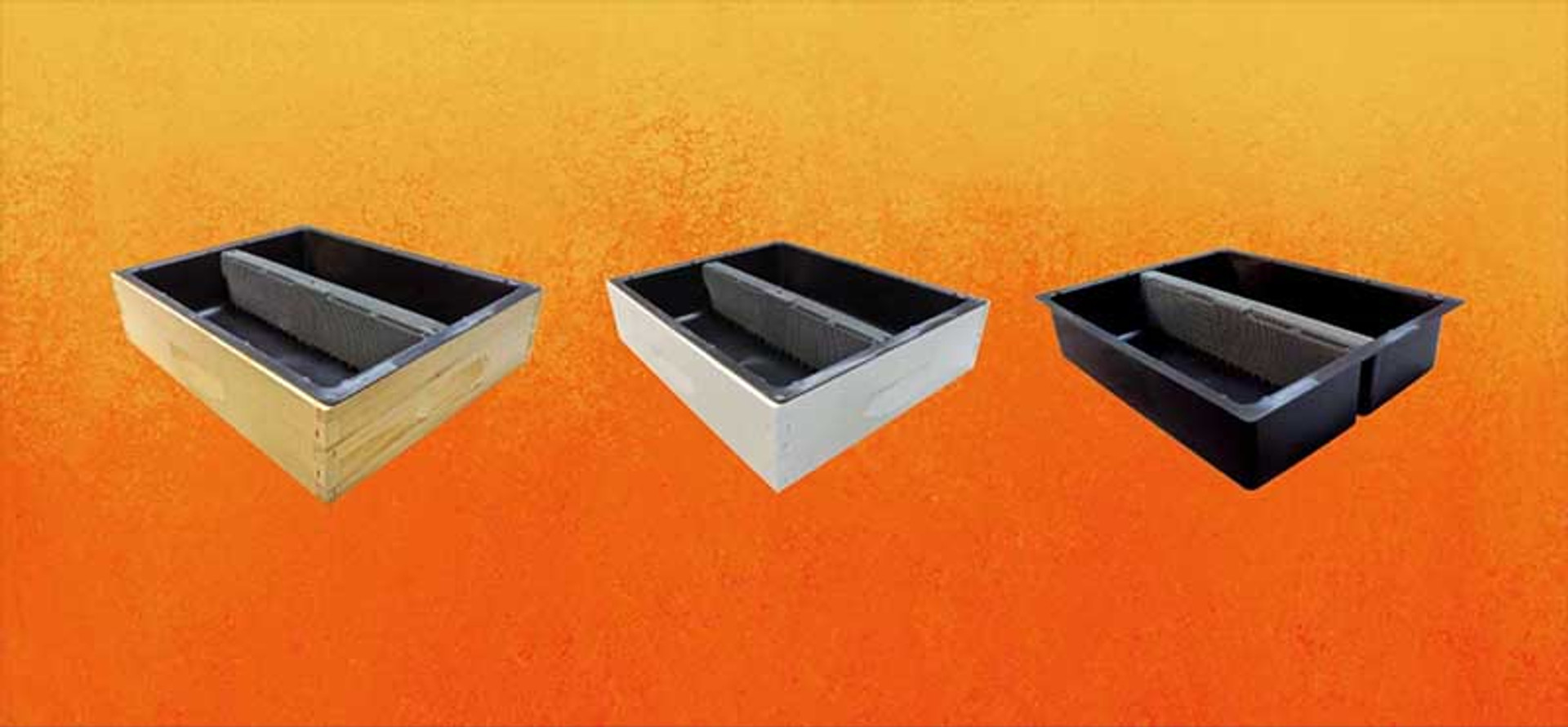Fall Prep: Top Feeders
What is a Top Feeder?
A top feeder sits on top of the upper box of the beehive. An empty hive box is placed around the feeder. Top Feeder designs vary, but the basic setup is a shallow box with a reservoir to hold syrup, and hardware cloth to allow bees access to the syrup while preventing them from drowning. Top feeders come in sizes to fit both 8-frame and 10-frame equipment. This is to protect it from the sun, wind, rain, and robber bees.
The top feeder is essential for bees because they are protected from the sun and hold the syrup. Most beekeepers feed their colonies syrup, typically in the spring and/or fall. Feeding syrup can be used to promote colony growth, keep them alive during a time of scarcity, or create and maintain sufficient winter food supplies.
Top feeders' wide open shape makes filling them faster and simpler than with gravity or frame feeders, which might lessen the chance of syrup spillage and deter theft. Refilling a top feeder doesn't disturb the colony because it only requires taking off the inner cover and lid to get to the feeder, leaving the bees below unaltered.
When the season of feeding is finished, it is easy to rinse out the syrup reservoir of the top feeder and let it dry before stacking for storage. Another appealing aspect of top feeders is that, unlike gravity feeders, they are not vulnerable to leaks brought on by changes in temperature or faulty seals.
When it comes to finding the perfect beehive feeders, choose from our professional bee feeders’ selection. Explore our large honey bee feeder selection to find the perfect solution for your beehive. Every honey bee feeder we carry is strong, durable, and easy to clean due to its exclusive designs. We have countless feeders available, which include the Max Pro Feeder, Frame Top Feeder Inserts, Bee Bar Caps, and Boardman Entrance Feeders.
Our bee feeders are equipped with various features to help improve the current way you care for your bees. See how our honey bee feeder selection can enhance your beehive and make beekeeping simple.

Benefits of Using a Top Feeder
Prevents Robbers
Beekeepers are concerned that having feeders, may draw robbers. That is a chance, particularly if you're utilizing an entrance feeder. But utilizing a top feeder will lessen robber bees. That is a result of the top feeder being enclosed in a box to prevent theft.
Keeps Syrup Out of the Sun
The top feeder is shielded from wind, rain, and, most crucially, sun because it is located inside the hive. A top feeder can be used to medication your bees if necessary because it is shaded from the sun. With entry feeders, you can't do this since the sunshine will make the drug less effective.
Less Invasive
Because the top box will be empty, monitoring a top feeder is far less invasive than checking a frame feeder. This implies that you won't need to use a smoker and that your chances of being stung are quite low.
How to Use a Top Feeder for Bees
All beekeepers should utilize a top feeder for bees. Simply lay the hive top feeder on top of the upper box. Next, make sure that your top feeder is shielded. Put an empty hive box around the feeder to do that. Regularly check your top feeder to determine whether it needs to be cleaned or refilled.
Before using top feeders, it's crucial to check that the hardware cloth is "bee tight" to block access from below. Bee drowning may be avoided by sealing any openings and using silicon to cover any holes big enough for bees. It is also crucial to prevent anyone from reaching the syrup from above, but doing so is simple as long as the inner cover is in excellent shape and rests flat on top.
When To Feed Bees
Bees are often able to find food on their own. Sometimes, though, they need assistance getting fed. Bees may benefit from being given syrup. Pairing liquid feed with a pollen substitute in your top feeder helps the bees rear healthy bees going into the winter. Feeding them 2-3 months before the first frost going into the winter ensures that the bees will have all the nutrients they need as they rear brood. Our top feeders also include a galvanized steel safety screen that helps prevent the bees from drowning in the liquid feed.
When you are installing a new package or having a swarm in new equipment, you will feed carbohydrates (sugar water or our pre-mixed Pro-Sweet syrup blend) to stimulate the bees wax glands to draw out the new foundation.
Bees also benefit from being fed pollen substitutes such as Ultra Bee. Bees must have both carbohydrates (nectar, sugar water or Pro-Sweet) and protein (pollen or pollen substitutes) in order to rear brood so supplemental feeding is very important in early spring and late fall after the honey has been removed. Feeding in early spring begins building the population of the hive.
The goal of every beekeeper raising a honey crop is to have the largest number of bees possible in the hive when the nectar flow starts and early brood rearing is the key to achieving optimal numbers. Ultra Bee and Bee-Pro® can be fed in patty form if it is too cold to fly or if the weather is nice and the bees can be out flying it can be fed dry in the bee yard. For your convenience, we have several types of patties available as complete brood rearing food. Adding our Pro Health to your liquid feed will encourage consumption and keep your feed fresher longer.
How do I Mix Syrup?
- 1:1, sugar to water for spring feeding
- 2:1, sugar to water for fall feeding
- 1:2, to water to stimulate brood rearing (to simulate a light nectar flow, make only 2 holes in the lid of the entrance feeder so bees will only receive small amounts at a time).
Building a New Colony
A bee feeder should always be taken into consideration when starting a new colony. Nucs will come equipped with supplies, but package bees have nothing to eat. Your new colony will be hungry in any case. If you decide not to feed your new colony, they will seek food on their own in a strange place while starving. That puts them in danger if they can't obtain food quickly enough. Because of these factors, beekeepers frequently employ bee feeders when starting a new colony.

